List of Syrian monarchs

The title King of Syria and Queen of Syria appeared in the second century BC in referring to the Seleucid kings who ruled the entirety of the region of Syria. It was also used to refer to Aramean kings in the Greek translations of the Old Testament; mainly indicating the kings of Aram-Damascus.
Following the defeat of the Ottoman Empire in World War I, the region came under the rule of France, United Kingdom and prince Faisal of Hejaz who was proclaimed King of Syria on 8 March 1920. Faisal's reign lasted a few months before he was overthrown by France and the title fell out of use.
Kings and Queens of Syria
Background
The term "Syria" was first applied by Herodotus in the 5th century BC to indicate a region generally extending between Anatolia and Egypt.[1][2] With the advent of the Hellenistic period, Greeks and their Seleucid dynasty used the term "Syria" to designate the region between the Mediterranean and the Euphrates.[3] The usage of the name in referring to the region during the Iron Age (ended 586 BC) is a modern practice.[1][4]
Seleucid dynasty
The Seleucid king Antiochus III the Great defeated the Ptolemaic Kingdom in the Battle of Panium (200 BC); he annexed the Syrian lands controlled by Egypt and united them with his Syrian lands, thus gaining control of the entirety of Syria.[5] Starting from the 2nd century BC, ancient writers, such as Polybius and Posidonius, began referring to the Seleucid ruler as the king of Syria.[6][7] The evidence for this title's usage by the kings is provided by the inscription of a certain Antigonus son of Menophilus, who described himself as the "admiral of Alexander, king of Syria" (Alexander refers either to Alexander I Balas or Alexander II Zabinas).[7]
| Portrait | Regent name (and lifespan) |
Reign | Consort (and reign) |
Parents, co-regents, and notes |
|---|---|---|---|---|
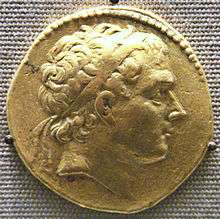 |
Antiochus III the Great (c. 241–187 BC) |
222–187 BC | Laodice III (222–c. 191 BC) Euboea (191–187 BC) |
|
| Antiochus (221–193 BC) |
210–193 BC | Laodice IV (196–193 BC) |
| |
| Seleucus IV Philopator (c. 218–175 BC) |
187–175 BC | Laodice IV (187–175 BC) |
| |
 |
Antiochus IV Epiphanes (c. 215–164 BC) |
175–163 BC | Laodice IV (c. 175–c. 163 BC) |
|
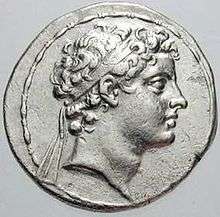 |
Antiochus V Eupator (172–161 BC) |
163–161 BC | Unmarried |
|
 |
Timarchus (unknown-160 BC) |
163–160 BC |
| |
 |
Demetrius I Soter (185–150 BC) |
161–150 BC | Laodice V (c. 161–150 BC) Apama |
|
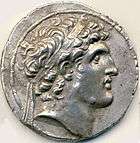 |
Alexander I Balas (unknown-145 BC) |
150–145 BC | Cleopatra Thea (150–145 BC) |
|
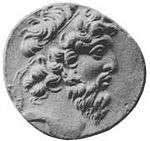 |
Demetrius II Nicator (unknown–125 BC) |
145–139 BC (first reign) |
Cleopatra Thea (145-137 BC) |
|
 |
Antiochus VI Dionysus (148 BC-142/1 BC) |
145–142 BC | Unmarried |
|
 |
Diodotus Tryphon (unknown-138 BC) |
142-138 BC |
| |
.jpg) |
Antiochus VII Sidetes (unknown-129 BC) |
138–129 BC | Cleopatra Thea (137-129 BC) |
|
 |
Alexander II Zabinas (unknown-122 BC) |
129–123 BC |
| |
 |
Demetrius II Nicator (unknown–125 BC) |
129–126 BC (second reign) |
Cleopatra Thea (129–126 BC) |
|
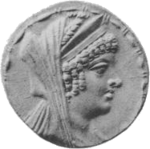 |
Cleopatra Thea (ca. 164-121 BC) |
126-125 BC (fourth reign) 125-121 BC (fifth reign) |
Unmarried as regent |
|
| Seleucus V Philometor (unknown-125 BC) |
126-125 BC | Unmarried |
| |
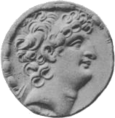 |
Antiochus VIII Grypus (unknown-96 BC) |
125–121 BC (first reign) 121-96 BC (second reign) |
Tryphaena (125-111 BC) Cleopatra Selene I (?-96 BC) |
|
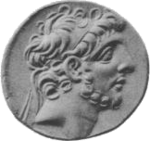 |
Antiochus IX Cyzicenus (unknown-96 BC) |
114–96 BC | Cleopatra IV (114-112 BC) Cleopatra Selene I (96-95 BC) |
|
 |
Seleucus VI Epiphanes (unknown-95 BC) |
96–95 BC |
| |
 |
Antiochus X Eusebes (unknown-92 or 83 BC) |
95–92 BC | Cleopatra Selene I (95–92 BC) |
|
 |
Demetrius III Eucaerus (unknown-88 BC) |
95–87 BC |
| |
| Antiochus XI Epiphanes (unknown-92 BC) |
95–92 BC |
| ||
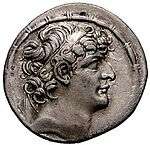 |
Philip I Philadelphus (unknown-83 BC) |
95–83 BC |
| |
 |
Antiochus XII Dionysus (unknown-84 BC) |
87–84 BC |
| |
 |
Tigranes the Great (140–55 BC) |
83–69 BC |
| |
%2C_50-30_B.C.E.%2C_71.12.jpg) |
Cleopatra Selene I (c. 135/130-69 BC) |
83-69 BC | Unmarried during reign |
|
| Seleucus VII Philometer (unknown-c. 58 BC) |
83–69 BC | Unmarried during reign |
| |
 |
Antiochus XIII Asiaticus (unknown-64 BC) |
69–64 BC |
| |
| Philip II Philoromaeus (unknown-64 or 56 BC) |
65–64 BC | Unmarried |
|
Antonia dynasty
| Name (and lifespan) |
Reign | Consort | Notes |
|---|---|---|---|
| Ptolemy Philadelphus (36-29 BC) |
34-31 BC | Unmarried |
|
Tanukhid rule
| Name (and lifespan) |
Reign | Consort | Notes |
|---|---|---|---|
| Mavia (unknown-425) |
375–425 | Widow during reign |
Hashemite dynasty
.svg.png)
Following the partitioning of the Ottoman Empire in the aftermath of World War I, Faysal bin Hussein of the House of Hashim was proclaimed King of the Kingdom of Syria on 8 March 1920 in Damascus, following the Arab revolt against the Ottomans of 1916–1918.
His accession was not recognized by France or the United Kingdom who became the new imperial powers in the region, and on 23 July 1920, the French moved 9,000 troops towards Damascus, resulting in the Battle of Maysalun. Faisal was expelled from Syria on 25 July and went into exile in the United Kingdom. On 10 August, the Treaty of Sèvres divided the region into League of Nations mandates governed by France and the United Kingdom.
| Portrait | Name (and lifespan) |
Reign | Consort (and reign) |
Notes |
|---|---|---|---|---|
 |
Faisal (20 May 1885-8 Sept 1933) |
8 Mar 1920 – 24 July 1920 | Huzaima bint Nasser (8 March 1920 – 24 July 1920) |
|
Biblical usage for Aramean kings
In the first translation of the Old Testament into Greek written during the third century BC (called the Septuagint),[26] Aram and Arameans were often translated as Syria and the Syrians;[27][28] hence the king was referred to as the king of Syria,[29] or the king of the Syrians,[30] and this was carried on by many English translations.[27] Aram in the Hebrew Old Testament and Syria in the translation indicated the kingdom of Aram-Damascus most of the times.[27][31] Occasionally, other Aramean regions were also referred to as Syria;[26][31] an example is the character known as "the Syrian of Paddan Aram, the sister of Laban the Syrian" where Syria does not designate Aram-Damascus but rather Paddan Aram in Mesopotamia.[32][33]
According to W. Edward Glenny, the rendering of Aram by Syria might be explained by an anti-Syrian bias, since at the time of the translation, Syria belonged to the Seleucids; the Jews' main enemy. Aram-Damascus was the Jews' enemy during its Iron Age prime in the 9th century BC.[34]
Aramean kings referred to as "kings of Syria"
| Portrait | Name (and lifespan) |
Reign | Parents, co-regents, and notes |
|---|---|---|---|
| Rezon the Syrian (unknown) |
10th century BC |
| |
| Hezion (unknown) |
circa 773 BCE |
| |
| Ben-Hadad I (unknown) |
885–865 BC | ||
| Ben-Hadad II (unknown–842 BC) |
880–842 BC | ||
 |
Hazael (unknown-circa 796 BC) |
842–796 BC |
|
| Ben-Hadad III (lifespan unknown) |
796–792 BC | ||
| Rezin (unknown-732 BC) |
754–732 BC |
|
See also
References
- 1 2 Trevor Bryce (2009). The Routledge Handbook of the Peoples and Places of Ancient Western Asia: From the Early Bronze Age to the Fall of the Persian Empire. p. 680. ISBN 9780415394857.
- ↑ Herodotus; George Rawlinson (1862). History of Herodotus, Volume 1. p. 126.
- ↑ Daniel Pipes (1992). Greater Syria: The History of an Ambition. p. 13. ISBN 9780195363043.
- ↑ Margreet L. Steiner; Ann E. Killebrew (2014). The Oxford Handbook of the Archaeology of the Levant: c. 8000-332 BCE. p. 94. ISBN 9780191662546.
- ↑ Paul J. Kosmin (2014). The Land of the Elephant Kings. p. 122. ISBN 9780674728820.
- ↑ Nigel Wilson (2013). Encyclopedia of Ancient Greece. p. 652. ISBN 9781136788000.
- 1 2 Paul J. Kosmin (2014). The Land of the Elephant Kings. p. 112. ISBN 9780674728820.
- ↑ Polybius, v. 43
- ↑ Bevan, ‘The House of Seleucus’, Vol.II, p.302
- ↑ Bevan, ‘The House of Seleucus’, Vol.II, p.230-231
- ↑ Schmitz, Leonhard (1867). "Alexander Zabinas". In William Smith. Dictionary of Greek and Roman Biography and Mythology. 1. Boston: Little, Brown and Company. pp. 127–128.
- 1 2 3
 One or more of the preceding sentences incorporates text from a publication now in the public domain: Chisholm, Hugh, ed. (1911). "Demetrius s.v. Demetrius II". Encyclopædia Britannica. 7 (11th ed.). Cambridge University Press. p. 983.
One or more of the preceding sentences incorporates text from a publication now in the public domain: Chisholm, Hugh, ed. (1911). "Demetrius s.v. Demetrius II". Encyclopædia Britannica. 7 (11th ed.). Cambridge University Press. p. 983. - ↑ "E. R. Bevan: The House of Ptolemy • Chap. X".
- ↑ Livy, Periochae 60; Justin 39.1.9
- ↑ Appian, Syriaca 69
- 1 2 Aidan Dodson, Dyan Hilton, The Complete Royal Families of Ancient Egypt, 2004
- 1 2 Cleopatra Thea by Chris Bennett
- 1 2 Antiochus IX Cyzicenus entry in historical sourcebook by Mahlon H. Smith
- 1 2 Manaseryan, Ruben (1985). "Տիգրան Բ [Tigran II]". Armenian Soviet Encyclopedia (in Armenian). 11. Yerevan: Armenian Encyclopedia Publishing. pp. 697–698.
- ↑ The House Of Seleucus V2 by Edwyn Robert Bevan.
- 1 2 "Cleopatra Selene queen of Syria".
- ↑ Cicero, In C. Verrem II 4.61, Appian, Syriaca VIII 49, XI 70, Justin, Historiarum Philippicarum T. Pompeii Trogi XL 2.2 (says Antiochus IX was his father). See also: C.J. Bennett, art. Cleopatra Selene queen of Syria, in Egyptian Royal Genealogy, 2002-2008 (n. 28).
- ↑ Cicero, In Verrem actio 4.61-68
- ↑ E.R. Bevan, The House of Seleucus, London, 1902, p. 263.
- ↑ David Konstan (2006). Greeks on Greekness: Viewing the Greek Past Under the Roman Empire. p. 6. ISBN 9780906014288.
- 1 2 Paul V.M. Flesher; Bruce D. Chilton (2011). The Targums: A Critical Introduction. p. 339. ISBN 9789004217690.
- 1 2 3 Bruce M. Metzger; Michael David Coogan (1993). The Oxford Companion to the Bible. p. 44. ISBN 9780199743919.
- ↑ James Strong; John McClintock (1867). Cyclopaedia of Biblical, Theological, and Ecclesiastical Literature, Volume 1. p. 353.
- ↑ Adam Clarke (1851). The Holy Bible Containing the Old and New Testaments: the Text Printed from the Most Correct Copies of the Present Authorized Translation, Including the Marginal Readings and Parallel Texts: Genesis to Esther. p. 843.
- ↑ Gerard Gertoux (2015). Kings David and Solomon: Chronological, Historical and Archaeological Evidence. p. 103. ISBN 9781329698109.
- 1 2 Thomas Nelson (2014). NIV, The Chronological Study Bible. p. 622. ISBN 9781401680138.
- ↑ Thomas Nelson (2013). KJV Study Bible: Second Edition. p. 52. ISBN 9781418589141.
- ↑ Brian Schultz (2009). Conquering the World: The War Scroll (1QM) Reconsidered. p. 191. ISBN 9004168206.
- ↑ Edward Glenny (2009). Finding Meaning in the Text: Translation Technique and Theology in the Septuagint of Amos. p. 152. ISBN 9789047429821.
- ↑ Luis Robert Siddall, The Reign of Adad-nīrārī III: An Historical and Ideological Analysis of An Assyrian King and His Times. BRILL, 2013 ISBN 9004256148 p.37
- ↑ Richard D. Nelson (2014). Historical Roots of the Old Testament (1200–63 BCE). p. 109. ISBN 9781628370065.
- ↑ Jeffrey Kah-Jin Kuan (2016). Neo-Assyrian Historical Inscriptions and Syria-Palestine: Israelite/Judean-Tyrian-Damascene Political and Commercial Relations in the Ninth-Eighth Centuries BCE. p. 125. ISBN 9781498281430.
External links
| Wikimedia Commons has media related to Monarchs of Syria. |